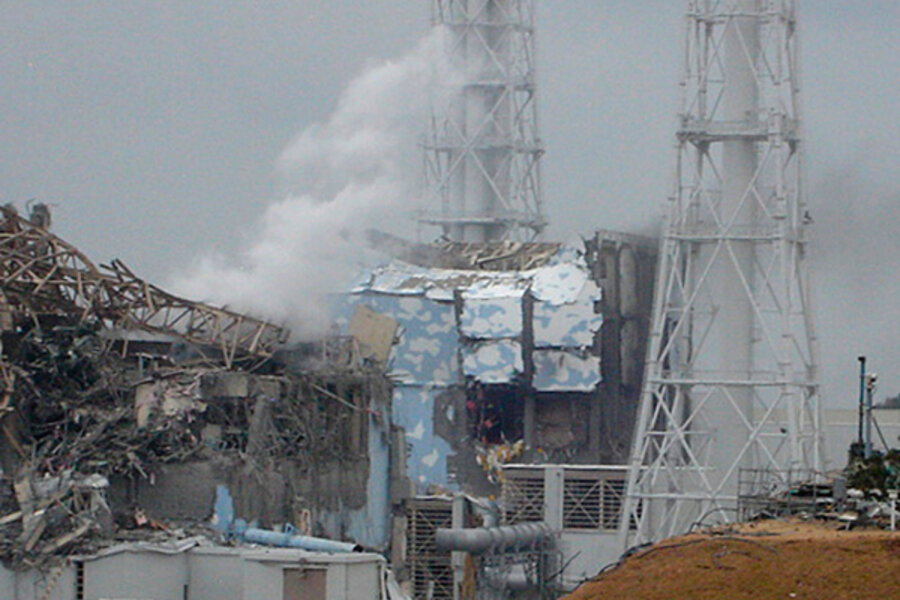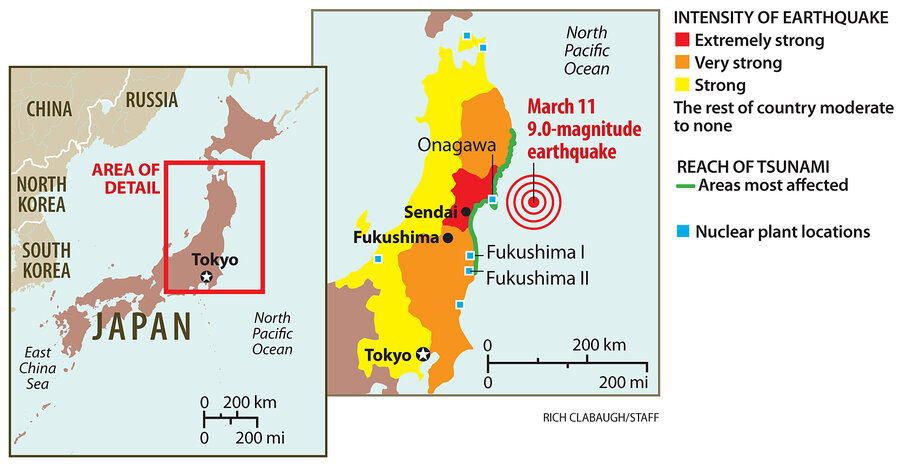Reports: Lax oversight, 'greed' preceded Japan nuclear crisis
Loading...
As Japan races to control a nuclear crisis in the wake of Friday's devastating earthquake and tsunami, the country's sterling image – as one of the nations most prepared to prevent and manage a disaster of this magnitude – is being tarnished.
Reports are emerging that both the United Nations' nuclear watchdog agency and the Japanese government failed to properly ensure the safety of the country's nuclear power industry.
The reports are challenging the recent refrain that the world's No. 3 economy couldn't have done better and once again highlighting how poor government oversight of an industry that allegedly cut corners to turn higher profits can spawn an environmental disaster.
Just as the BP oil spill one year ago heaped scrutiny on the United State's Minerals Management Service, harshly criticized for lax drilling oversight and cozy ties with the oil industry, the nuclear crisis in Japan is shining a light on that nation's safety practices.
Design flaws in nuclear reactor containment vessels?
Four out of six reactors at the Fukushima Daiichi nuclear power plant (also known as Fukushima I) have now suffered explosions or fires since a March 11 earthquake and tsunami devastated the region and knocked out electricity at the plant, which caused cooling systems to fail and reactors to suffer at least partial meltdowns.
Two of those reactor containment vessels may now have cracked and appear to be releasing radioactive steam. Their designer, General Electric, is now feeling heat for marketing the reactor despite safety concerns dating back three decades. Indeed, just as the BP oil spill drew scrutiny on several multinational companies, the crisis in Japan is underscoring a "flat world" where responsibility – along with environmental and economic fallout – spreads across oceans.
Russian nuclear accident specialist Iouli Andreev, who as director of the Soviet Spetsatom clean-up agency helped in the efforts 25 years ago to clean up Chernobyl, has lashed out against the UN's International Atomic Energy Agency (IAEA) and private corporations for failing to heed lessons from that 1986 nuclear catastrophe in Ukraine.
"After Chernobyl all the force of the nuclear industry was directed to hide this event, for not creating damage to their reputation. The Chernobyl experience was not studied properly because who has money for studying? Only industry," he told Reuters in an interview published Tuesday.
Reports that plant operator TEPCO cut corners
Dr. Andreev said the sequence of events at Japan's Fukushima I suggested that the plant's owner, Tokyo Electric Power Company (TEPCO), may have put profit before safety. The fire that broke out Tuesday in reactor No. 4's fuel storage pond may have been caused by a desire to conserve space and money, he suggested.
"The Japanese were very greedy and they used every square inch of the space. But when you have a dense placing of spent fuel in the basin you have a high possibility of fire if the water is removed from the basin," Andreev told Reuters.
TEPCO has come under fire in the past for falsifying safety records at the Fukushima Daiichi plant. In 2002, according to The Wall Street Journal, TEPCO admitted to the Nuclear and Industrial Safety Agency that it had falsified the results of safety tests on the No. 1 reactor.
This was only one in a string of scandals and coverups to mar the Asia's biggest utility company. In 2007, the company initially said there was no release of radiation after an earthquake damaged its Kashiwazaki-Kariwa plant, but later admitted that radioactive water spilled into the Sea of Japan.
And less than a year ago, on June 17, a reactor at Fukushima I lost electricity and saw a dangerous drop in cooling water, Bloomberg reported. TEPCO's president failed to adequately investigate to prevent the current crisis, said Iwaki City council member Kazuyoshi Sato.
“Tokyo Electric and the government’s Nuclear and Industrial Safety Agency had too much faith and confidence in the safety of the plant and were lax in their response,” Mr. Sato told Bloomberg News.
Cozy relations within industry
But if the plant was lax in its response, where was the government agency whose job it is to enforce safety regulations? Indeed, seemingly cozy relations within the nuclear industry between regulators and operators are now also under the spotlight.
TEPCO and the Japanese government have partnered in the past to market nuclear power. In August, TEPCO's chairman joined the head of Japan's Ministry of Economy, Trade, and Industry on a trip to Vietnam to promote the sale of Japanese nuclear power plants. (Vietnam later chose TEPCO.)
Japan's nuclear crisis: A timeline of key events
Andreev, the Russian scientist, has also accused the IAEA of being too close with corporations. "This is only a fake organization because every organization which depends on the nuclear industry – and the IAEA depends on the nuclear industry – cannot perform properly."
IAEA officials defended the agency, saying this characterization showed a misunderstanding of their mandate. "The agency can facilitate the creation of a standard but cannot enforce that standard," one anonymous official told The Guardian. The IAEA is dependent on member states for voluntary compliance and control of information.
Two Japanese members of the IAEA have specifically been targeted.
Yukiya Amano, a Japanese diplomat named deputy director general for the IAEA's Department of Nuclear Safety and Security in 2009, has been lambasted for apparent delays in issuing crisis updates. Mr. Amano's predecessor, Tomihiro Taniguchi, was criticized by the US more than two years ago for being "weak" on safety practices.
"[Tomihiro] Taniguchi has been a weak manager and advocate, particularly with respect to confronting Japan's own safety practices, and he is a particular disappointment to the United States for his unloved-step-child treatment of the Office of Nuclear Security," the US State Department said in a secret cable that was released to The Guardian by the secret-spilling website WikiLeaks.
Reexamining GE's reactor design
American company General Electric (GE) has also come under fire for its design of the damaged nuclear reactors at Fukushima I.
As early as 1972, American regulators considered discontinuing GE's Mark 1 system, according to The New York Times. "Among the concerns cited was the smaller containment design, which was more susceptible to explosion and rupture from a buildup in hydrogen – a situation that may have unfolded at the Fukushima Daiichi plant," according to the article.
The ban idea was nixed because of the industry's preference for the design. Today in the US, 23 reactors at 16 locations still use the Mark 1 design, according to the antinuclear power Nuclear Information and Resource Service (pdf). The nonprofit has released documents dating back to 1972 on its website.
"The concern has been there all along that this containment building was not strong enough and the pressure containment system was not robust enough to prevent an explosion," Director Michael Mariotte said in a statement.
While the world's biggest nuclear-equipment supplier has maintained that its containment vessels are reliable, three GE employees quit in 1975 in protest over safety concerns around GE's so-called Mark 1 reactor containment vessel. Resigned employee Dale Bridenbaugh told ABC News that the rapid loss of cooling water in a reactor, as has happened now in Japan, "could tear the containment apart and create an uncontrolled release."







